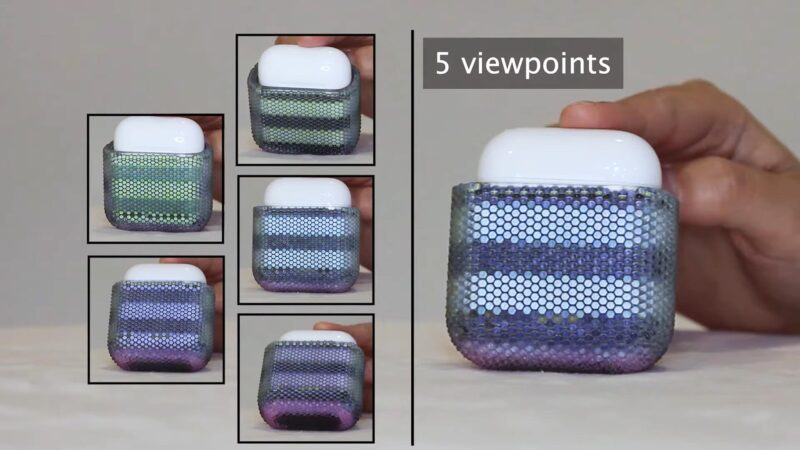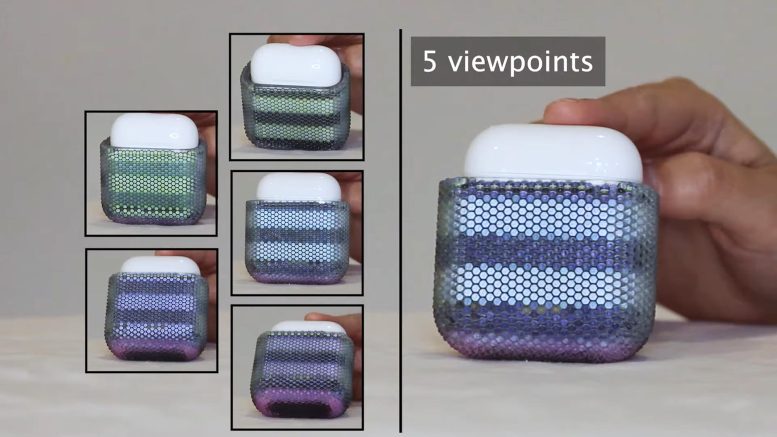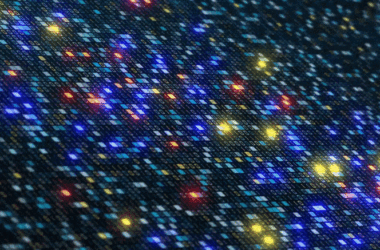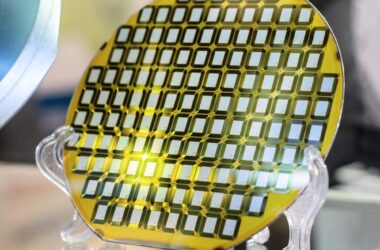Par
Un outil d’édition rend le processus de fabrication accessible à tous.
Imaginez une carte d’anniversaire qui passe de l’image d’un gâteau d’anniversaire à celle de fleurs lorsque vous la tournez et la regardez sous différents angles. Vous pouvez sans doute trouver d’autres exemples de ce type de morphing d’images dans des publicités, par exemple. Jusqu’à présent, cependant, l’effet était limité aux surfaces planes.
Entrez dans le travail de MIT qui, pour la première fois, ont mis au point un système permettant de créer des objets en 3D qui changent d’apparence lorsqu’ils sont vus de différents points de vue. La même équipe a également développé un outil d’édition disponible gratuitement. en ligne qui peut permettre à quiconque de concevoir et de construire de tels objets en 3D, le tout par le biais de l’impression 3D.
Vidéo sur les objets 3D créés au MIT qui changent d’apparence selon les points de vue. Crédit : Zeng et al., MIT
“Notre travail ouvre l’idée de ce que peut être un objet physique”, explique Yunyi Zhu, étudiant diplômé du MIT au département de génie électrique et d’informatique (EECS). “Il s’inscrit dans une vision plus large de la fabrication d’objets dynamiques qui changent d’apparence, de couleur et de forme. Nous abordons la question de l’apparence, qui est l’une des dimensions du concept d’objets reprogrammables”, explique M. Zhu, qui est coauteur principal d’un article sur ces travaux, présenté en octobre au 2021 Symposium on User Interface Software and Technology de l’Association for Computing Machinery.
Stefanie Mueller est le chef de file de ces travaux, professeur adjoint en EECS, et auteur de l’article. Mueller est également affiliée au laboratoire d’informatique et d’intelligence artificielle du MIT.
Les autres co-premiers auteurs de l’article sont Jiani Zeng (un étudiant diplômé du MIT qui a depuis obtenu son diplôme) et Honghao Deng (un étudiant diplômé de Harvard qui a depuis obtenu son diplôme). En plus de Zhu, Zeng, Deng et Mueller, les autres auteurs sont Michael Wessely, un associé postdoctoral en EECS, et Axel Kilian, un professeur adjoint invité dans le département d’architecture.
“Cette recherche passionnante modifie radicalement l’avenir de la conception des produits. [will] ressembler. En tant que designer d’interaction, j’ai été stimulé en imaginant comment, à l’avenir, les objets physiques quotidiens pourraient avoir des milliers d’apparences différentes (couleurs et motifs) en fonction des angles de vue. Je peux penser à de nombreuses applications, depuis les dessins de mode hypnotiques jusqu’aux sculptures esthétiques qui transmettent différents récits poétiques en fonction des points de vue”, explique Ken Nakagaki, associé postdoctoral au MIT Media Lab et futur professeur adjoint au University of Chicago. Nakagaki was not involved in the work.
How it Works
The changing images on a flat card—and now 3D objects—are thanks to many tiny lenses printed across the card or object. About six of the lenses created by the MIT team could fit across the surface of a dime. Known as lenticular lenses, each lens covers a pattern of tiny colored image spots.
“Because of the magnifying effect of the lens, it displays the color from only one of the colored image spots, which is only a small portion of the entire area under the lens,” the authors write. Which magnified spot the viewer sees depends on the viewer’s viewpoint and the “different incident angles of the light hitting the lens” from that viewpoint. Multiple lenses together “form a lenticular display and collectively show an image that varies dependent on viewpoint.”
The MIT team’s editing tool takes as input the 3D model, or object, that is desired as well as the images that a designer wants to morph from one into another. It then calculates the lens placement and color pattern across the object’s surface that will lead to the desired effect. The designer can then preview the resulting object before sending the “directions” to a 3D printer, where the object, color patterns, and lenses are all printed in one pass.

A kettlebell guides a user to the correct position for holding the device during exercise. It was created using tools developed at MIT that allow 3D objects to change their appearance from different viewpoints. Credit: Zeng et al., MIT
Many Applications
The team went on to create four examples of 3D objects with images that change based on the viewer’s perspective. The idea was to demonstrate the ability to create objects with different geometries, different image complexities, and varying numbers of morphing images. The demonstration objects, each of which are printed with thousands of lenses, include:
- A kettlebell for exercise that can indicate to the user whether they are holding the device properly. If the device is too low, an arrow pointing up appears; if too high, an arrow pointing down takes its place. The correct position is indicated with a check mark.
- A bedside lampshade that displays different greetings depending on whether a person is sitting up in bed (Good Day) or lying down (Good Night).
- A case for earpods that flickers between several colored stripes depending on how the user handles it.
- A shoe printed with a motivational message that only the user can see (the message is invisible to a bypasser or someone standing nearby).
The Sweet Spot
Zhu says that the major challenge involved in the work was determining the “sweet spot” for the size of each lens. “The smaller the lens, the better the resolution,” she says. “But smaller lenses also have more defects, so the fabrication quality will be worse.” Zhu and colleagues ultimately found that a lens that’s three millimeters in diameter “fits most needs.”
The team also tested other parameters, including the orientation of a lens (for example, printed facing upwards or sideways) and various post-processing techniques for the lenses. Lenses facing upwards and treated with painting varnish led to the best results.
It took about two years to move the project from concept to the creation of demonstration objects. The best part of the work for Zhu was “seeing that the process actually works and holding an object in my hand. That was extremely satisfying.”
Reference: “Lenticular Objects: 3D Printed Objects with Lenticular Lens Surfaces That Can Change their Appearance Depending on the Viewpoint” by Jiani Zeng, Honghao Deng, Yunyi Zhu, Michael Wessely, Axel Kilian and Stefanie Mueller, 12 October 2021, UIST ’21: The 34th Annual ACM Symposium on User Interface Software and Technology.
DOI: 10.1145/3472749.3474815
This work was supported by the National Science Foundation and by the MIT Materials Research Laboratory under the MIT.nano Immersion Lab Gaming Program funded by NCSOFT.




